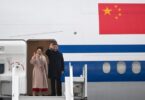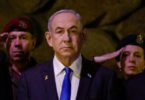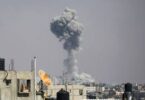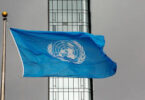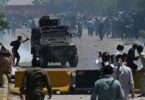Iqbal Khan
Prime Minister Narendra Modi had composed President Donald Trump’s visit as a demonstration of India’s rising stature on the world stage. However, as President Donald Trump toured India’s capital, at least 11 people were killed in mob violence. While the duo discussed geopolitics in the New Delhi, Hindus and Muslims comprising thousands of furious residents faced off again, hurling petrol bombs, attacking vehicles, burning properties and hospitalizing the injured and dead.
And gone are the days when no World leader could pronounce word ‘K’, especially on Indian soil. During his two days visit to India, President Donald Trump reiterated his offer to mediate Kashmir dispute. Hid did so publically as well as behind back door interactions. “Willing to mediate between India and Pakistan on Kashmir,” he was quoted as saying during the press conference on Feb 25. This is the third time that Trump has offered both nuclear armed neighbours to help resolve the long-standing Kashmir conflict.
The US president said his administration is hopeful for “reduced tensions and greater stability” between Pakistan and India. “Our relationship with Pakistan is a very good one. Thanks to these efforts, we are beginning to see signs of big progress with Pakistan.”
The violence drew sharp reactions from US lawmakers, with Democrat Representative Rashida Talib, tweeting, “This week, Trump visited India but the real story should be the communal violence targeting Muslims in Delhi right now.” Modi had promised him crowds of up to 10 million people. The actual number lining the streets of Ahmedabad was well under one-tenth that amount. Despite saying he had been told his greeting was the greatest “ever given to any head of state from any country.”
On 3rd day of violence, Modi Urged Calm “I appeal to my sisters and brothers of Delhi to maintain peace.” According to New York Times, he called for a quick restoration of “calm and normalcy.” “Peace and harmony are central to our ethos,’’ Modi Twittered, a day after hosting President Trump. Indian government is controlled by a Hindu nationalist party that has been widely accused of marginalizing India’s Muslim minority, which, at 200 million, is one of the world’s largest Muslim populations.
Shops, Muslim shrines and public vehicles were left smoldering from violence. These clashes are the worst communal riots in the Indian capital in decades. According to Jaffery Gettleman, Much of the blame for the violence in Delhi is falling on Kapil Mishra, a local politician from ruling BJP party. On Feb 23, Mishra threatened to mobilize a mob to clear out protesters who have been demonstrating against a new citizenship law. Reportedly, Mishra said he did not want to create trouble during Trump’s trip. But he warned the police that as soon as Trump left India his followers would take action against the protesters. Police spokesman M.S. Randhawa said 106 people were arrested for alleged involvement in the rioting.
New Delhi’s Chief Minister Arvind Kerjiwal, called for Modi’s home minister, Amit Shah, to send the army to ensure peace. Sonia Gandhi, a leader of the Congress party, called for Shah to resign. She accused Bharatiya Janata Party (BJP) of creating an environment of hatred and its leaders of inciting violence with provocative speeches that sought to paint Muslim protesters against the citizenship law as anti-nationalists funded by Pakistan.
President Trump stressed the strength of his relationship with Modi in meetings long on symbolism and short on concrete agreements. Two leaders celebrated a series of modest agreements that had been set before the trip. Trump and Modi’s warmth did not translate into trade. A trade deal with India has been a priority for two years for Trump, who would like another economic agreement to show while campaigning before the November election. But the two sides have been divided over farm products, medical devices, digital trade and new tariffs. Trump has complained that India treats the United States unfairly and called Modi a “tough negotiator.” “Our teams have made tremendous progress on a comprehensive trade agreement, and
Trump talked about some of his longstanding complaints about India’s trade policies, complaining to reporters that New Delhi maintained unfairly high tariffs on American goods. Trump and Modi celebrated a series of modest agreements. There was huge disparity between the hopes and on ground achievements.
Prime Minister Imran Khan described US President Donald Trump’s recognition of Pakistan’s anti-terrorism efforts during his trip to India as a diplomatic win for Islamabad. New Delhi’s nefarious designs against Islamabad stood thwarted as Modi failed to sell his anti-Pakistan narrative to the US. Trump urged Modi’s government to respect freedom on the internet, which the Indian government has shut down repeatedly.
Viewed from India prism, it was a failed summit. US$ 3 billion arms deal itself is a tight slap in face of Modi’s ‘Make in India’ rhetoric. Trump now owns Kashmir conflict that was talked about publically and more vigorously behind closed doors.
In India we are seeing the Nazi-inspired RSS ideology take over a nuclear-armed state of over a billion people. Whenever a racist ideology based on hatred takes over, it leads to bloodshed. At least 24 people were killed and 189 injured in three days of sporadic clashes in New Delhi that coincided with President Trump’s first state visit to India, with the death toll expected to rise.
Trump must be wondering about first-hand experience of “Rising India”. Images of burning “largest democracy” would sooner than later convince Trump to correct his perspective about India. Probably Trump visited India to discuss only Kashmir. Hopefully, his twitter would soon break the story, then Modi will desperately look for a place to hide.
Iqbal.khan9999@yahoo.com

